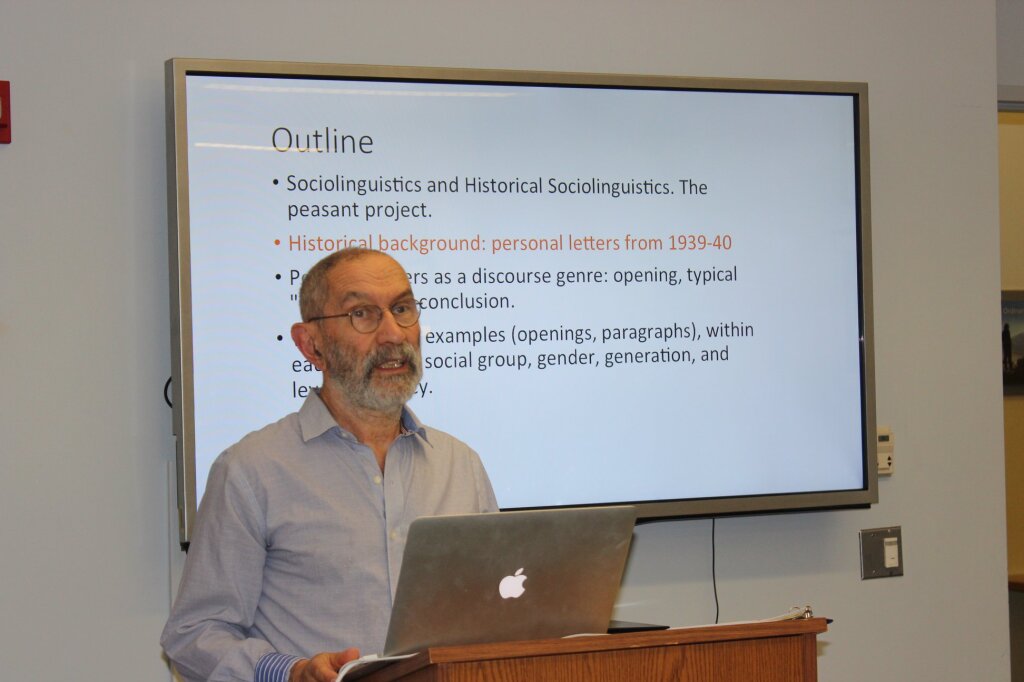Watch the event video here!
On Wednesday May 2, the Jordan Center hosted an event entitled, “Social divisions among the barely literate in the Soviet Union of 1939-40: an exercise in historical sociolinguistics”, a talk by Alexander Nakhimovsky, Director of the Linguistics Program at Colgate University. The event was part of the Occasional Series and was introduced by Brandon Schechter, Elihu Rose Scholar in Modern Military History in the History Department at NYU.
As a scholar of historical sociolinguistics, Nakhimovsky investigates and reconstructs social dialects from written historical sources. This particular talk addressed the issue of whether peasants of early 20th century Russia possessed a single social dialect. While such peasants certainly demonstrated a particular lifestyle, the concept of syntax did not yet exist. They used particular word forms, but such language was largely blended into the common vocabulary of the proletariat. Thus, Nakhimovsky’s goal was to define in precise linguistic terms the nature of peasant discourse in written correspondence through diachronic and synchronic frames of historical sociolinguistics.
Much of the conclusive data from his study was obtained from the work of author Vladimir Zenzinov. The Molotov-Ribbentrop Pact of 1939 resulted in the division of central Europe, and following the Soviet attack on Finland, Finns collected letters found on the bodies of Red Army soldiers. Zenzinov managed to obtain 500 of these and published 276 of them. All letters were addressed to or written by Soviet servicemen and over half were sent from women. Close inspection of syntax and structure was very reflective of the social status and education level of the authors. The majority of the letters demonstrated common elements in their structure, including report of personal circumstances, requests for help and answers to previous questions.
The letters did, however, demonstrate distinctions between formal and informal modes of address. The first example presented by Nakhimovsky was a letter from a soldier, in which the author employed the formal mode of address of name, last name and patronymic, although the name was shortened as the letter continued. The letter was also filled with grammatical errors. Nakhimovsky observed interesting distinctions between the language of urban and rural peasant women. Urban young women often opened their letters with a light “ditty”, such as “Happy day and merry hour” or “What are you up to, my dear flower?” Young peasant women used similar phraseology but in a more formulaic way.
The correspondence of schoolteachers and schoolchildren were analyzed as well. Many of these letters demonstrated the pattern of starting the letter with the addressee’s name i.e. “Kolya” and continuing the letter without any punctuation or separation between sentences. Nakhimovsky noted that peasant writing often followed the structure of direct speech. In spite of the fact that starting in 1930 free elementary education was required for all, there were only a handful of people with perfect grammar.
Overall, Nakhimovksy’s study revealed particular characteristics specific to peasant discourse. All letters analyzed demonstrated a traditional opening and the same treatment of forms of address and pronouns as well as repeating nicknames throughout the body of the letters. Additionally, peasants commonly used the word skuchat (typically referring to “boredom” in Russian) to describe “anguish.” All letters used direct speech as well as old Russian syntax and phraseology. Finally, the content of the letters most commonly focused on the personal circumstances and life details of the authors. The language and literacy level of written correspondence thus places the authors into recognizable social categories. The consistent high level features typical for peasant letters conclusively positions peasants’ language into a specific social dialect.
Following the lecture, one audience member pointed out the similarity between the style of the peasant letters and Isaac Babel’s story “The Letter.” Nakhimovsky insisted that Babel is actually more concentrated in his style; the work of Platonov in fact might be more representative of peasant language. In his work on World War II, Brandon Schechter found that official language had infiltrated soldiers’ letters by this period – what changed between the Finnish situation and World War II? Nakhimovsky contended that once education had become more widespread, peasant language began to disappear. Concerning his personal scholarly preferences, he also found soldiers’ letters to be overly direct and aggressive and does not find them to be so interesting linguistically.



